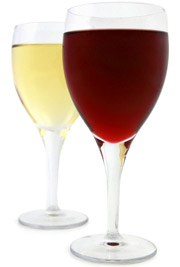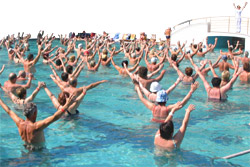Eating and exercising your way through menopause
We all know that what we eat and how we exercise influences our health. But have you ever thought about how eating and exercising can be used to improve your health during and after menopause?
While most women experience at least some menopausal symptoms like hot flushes and mood swings, and the risk of conditions like osteoporosis and breast cancer increases following menopause, healthy eating and regular exercise help you keep your body in top shape. This not only reduces the likelihood you’ll experience menopausal symptoms, it also reduces your risk of health conditions later in life.
Performing regular exercise and maintaining a healthy diet are the key considerations; however, the right types of food and exercise are slightly different for menopausal women.
A healthy balanced menopausal diet
A healthy balanced diet in the menopausal period is one which will help you maintain a healthy body mass index (BMI) and reduce the risk of osteoporosis and breast cancer in the future. Limiting calories, to ensure you do not become overweight or obese, is of great importance. If you’re overweight when menopause begins, losing weight is likely to make the transition through menopause easier, and will also prepare your body for healthy post-menopausal living. With a healthy weight you’ll have a lower risk of cardiovascular disorders, nutrition related disorders like type 2 diabetes mellitus and breast cancer following menopause. It’s also less likely that you’ll experience hot flushes, a common and unpleasant symptom of menopause.
Avoid alcohol for fewer hot flushes and healthy breasts and bones 
Cutting out alcohol or minimising how much you drink is a great way to reduce the number of calories you consume. But because alcohol contains a lot of calories without any essential nutrients, cutting out health fruit and vegetables so you can have an alcoholic drink without blowing your calorie limit won’t work. You’ll be depriving your body of the nutrients it needs to stay healthy. Limit yourself to two standard drinks (one standard drink is the equivalent of about 100 ml of wine) on any given day and seven standard drinks per week. This will also reduce your risk of hot flushes during menopause.
But don’t stop limiting alcohol consumption when you’re hot flush free. It’s also important to restrict alcohol consumption in the years post-menopause. Even though it may not seem like a lot, consuming two standard drinks is enough to increase your risk of falling. Bones become weaker and women are at increased risk of osteoporosis post-menopause, which means falling comes with the potential to cause a serious injury like hip or spine fracture. In addition, limiting alcohol will reduce the likelihood you’ll get breast cancer. Consuming just one standard drink per day increases your risk of developing breast cancer by 9%, and the more you drink the higher your risk becomes.
Eating essential micronutrients
Restricting alcohol consumption will mean you have more calories to use up eating nutritious foods which your body needs to stay healthy. Foods containing calcium, magnesium, vitamin K and protein are important at this time of life, so ensure you’re consuming plenty of low-fat dairy and fruit and vegetables, and moderate portions of meat, legumes (root vegetables such as potatoes) or fish every day. With this combination, you’ll keep your bones and your body healthy.
During menopause you might also consider adding a red clover phytoestrogen supplement (such as Promensil) to your diet. Phytoestrogens are compounds found in plants which act like a very weak dose of oestrogen. Studies have shown that phytoestrogens from red clover can help improve your mood during menopause.
Keep your body moving during menopause and beyond
Exercise is also a proven way to improve your mood during menopause, particularly if you’ve already experienced your final menstrual period. But if you’re hoping to turn your mood swings around and ward off anxiety and depression with exercise, be ready for a good workout, and be ready to stick with it. You don’t have to spend hours swinging at a punching bag, but on the other hand a short stroll in the park is probably not enough. Studies have shown that moderate and high (but not low) levels of physical activity improve mood in menopausal women.
If you’re approaching menopause but still experience irregular menstrual bleeding; a word of caution regarding exercise. It’s been shown to reduce stress but might increase feelings of anxiety and depression. However, it’s still important to exercise, given the benefits it will provide you later in life. Staying physically active increases muscle and bone strength, agility and balance, which will in turn reduce your risk of falls and fractures. Regular exercise will also make maintaining a healthy weight much easier, and, as we’ve already discussed, there are loads of health benefits which come with healthy weight.
Steer clear of dangerous exercises
Whatever stage of menopause you’re at, think carefully about the types of exercises you perform. Vigorous, weight-bearing exercise which increases your strength are what your body needs, but high impact exercises like aerobics and step classes come with an increased risk of falling, as does exercising on a slippery surface. Other forms of physical activity like contact sports may also increase your risk of injury. Although you’re unlikely to fall over doing sit-ups or toe touches, these exercises may also be dangerous. The repeated motions create pressure on your trunk and spine which can cause injury.
Choose weight-bearing and strengthening exercises
Put aside ‘dangerous’ physical activities in favour of a good brisk walk or a dip in the pool for a session of water aerobics, which can be vigorous but is low impact. Walking is a good form of weight-bearing exercise which will strengthen your bones and muscles, but you might also like to try a bit of strength training. You won’t need to buy an expensive gym membership or purchase expensive equipment; strength bands and free weights – which are inexpensive – can provide you with a good strengthening workout. Focus on exercises which target important muscle groups like those of the back, hips, thighs, forearms and upper arms.
The right combination
Menopause and the years beyond throw up many challenges for women, but the right combination of diet and exercise can make these years much easier, healthier and more enjoyable. Eating healthy foods and regular physical activity will not only reduce the likelihood you’ll experience menopausal symptoms like hot flushes and mood swings. It will also ensure your body is in top shape for a life free of osteoporosis, breast cancer and heart disease after menopause.
More Information
 | For more information on menopause, including symptoms and management of menopause, as well as some useful animations and videos, see Menopause. |
References:
- Nelson DB, Samme MD, Freeman EW, et al. Effect of physical activity on menopausal symptoms among urban women. J Med Sci Sport Exercise. 2008; 40(1): 50-8. [Abstract | Full Text]
- Wylie-Rosett. Menopause, micronutrients, and hormone therapy. Am J Clin Nut. 2005; 81(sup): S1223-31. [Full Text]
- Burbos N, Morris E. Menopausal symptoms. BMJ Clin Evid. 2010; 2: 804.
- Whitman MK, Staropoli CA, Langenburg PW, et al. Smoking, Body Mass, and Hot Flashes in Midlife Women. Obstet Gynaecol. 2003; 101(2): 264-72. [Abstract | Full Text]
- Huang AJ, Subak LL, Wing R, et al. An intensive behavioural weight loss intervention and hot flushes in women. Arch Intern Med. 2010; 170(13): 1161-7. [Abstract | Full Text]
- Lipovac M, Chedraui P, Gruenhut C, et al. Improvement of postmenopausal depressive and anxiety symptoms after treatment with isoflavones derived from red clover extracts. Maturitas. 2010; 65(3): 258-61. [Abstract]
- North American Menopause Society. NAMS continuing medical education activity- Management of osteoporosis in postmenopausal women: 2010 position statement of The North American Menopause Society. Menopause. 2010; 17(1): 23-56. [Abstract]
- Silverman NE, Nicklas BJ, Ryan AS. Addition of aerobic exercise to a weight loss program increases BMD with an associated reduction in inflammation in overweight postmenopausal women. Calcif Tissue Int. 2009; 84(4): 257-65. [Abstract | Full Text]
- Holmes MD, Willet WC. Does diet affect breast cancer risk? Breast Cancer Res. 2004; 6(4): 170-8. [Full Text]
- Australian Government Department of Health and Ageing. Healthy Eating- Energy in Food. 2009. [cited 25 April 2012]. Available from: URL Link
- Kellet E, Smith A, Schmerlaib Y. Australian Guide to Healthy Eating. Australian Government Department of Health and Ageing. 1998. Available from: URL Link
Dates
Tags
Created by:

 Login
Login














